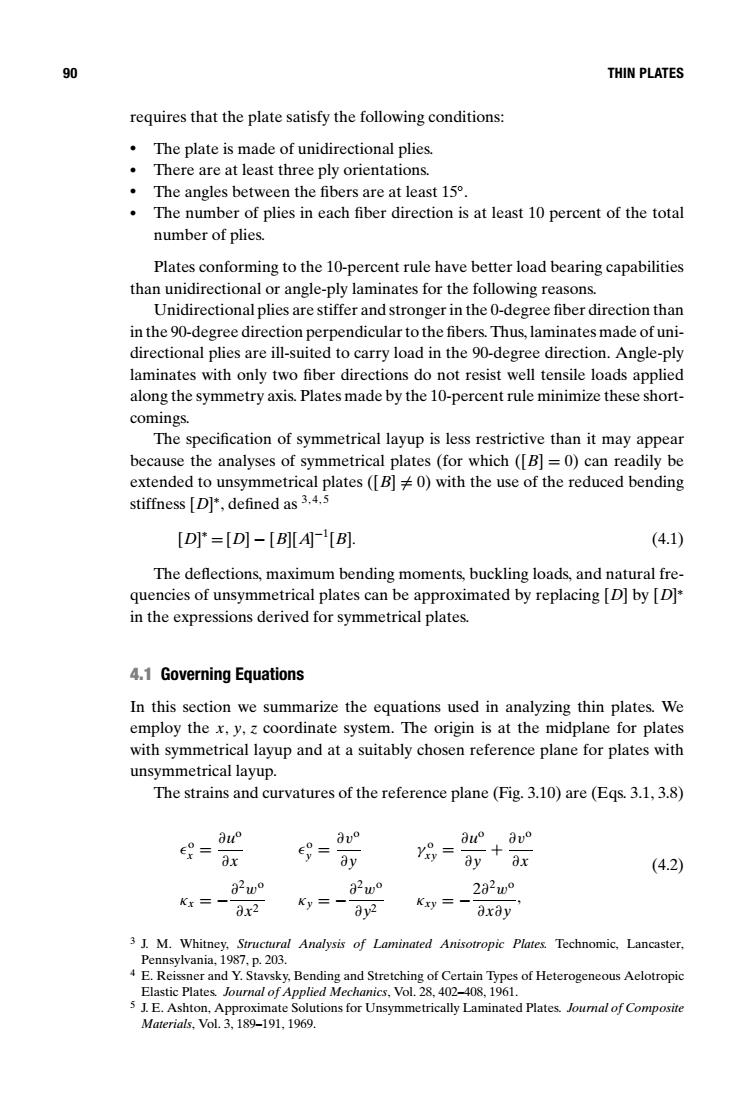正在加载图片...

90 THIN PLATES requires that the plate satisfy the following conditions: The plate is made of unidirectional plies. There are at least three ply orientations. ·The angles between the fibers are at least 15° The number of plies in each fiber direction is at least 10 percent of the total number of plies. Plates conforming to the 10-percent rule have better load bearing capabilities than unidirectional or angle-ply laminates for the following reasons. Unidirectional plies are stiffer and stronger in the 0-degree fiber direction than in the 90-degree direction perpendicular to the fibers.Thus,laminates made of uni- directional plies are ill-suited to carry load in the 90-degree direction.Angle-ply laminates with only two fiber directions do not resist well tensile loads applied along the symmetry axis.Plates made by the 10-percent rule minimize these short- comings. The specification of symmetrical layup is less restrictive than it may appear because the analyses of symmetrical plates(for which([B]=0)can readily be extended to unsymmetrical plates ([B]0)with the use of the reduced bending stiffness [D]*,defined as 3.4.5 [D*=[D]-[BA-[B (4.1) The deflections,maximum bending moments,buckling loads,and natural fre- quencies of unsymmetrical plates can be approximated by replacing [D]by [D]* in the expressions derived for symmetrical plates. 4.1 Governing Equations In this section we summarize the equations used in analyzing thin plates.We employ the x,y,z coordinate system.The origin is at the midplane for plates with symmetrical layup and at a suitably chosen reference plane for plates with unsymmetrical layup. The strains and curvatures of the reference plane(Fig.3.10)are (Egs.3.1,3.8) au° e= avo au°,8v° ax 9= ay y,= ay ax (4.2) 02w° 82w0 282w° Kx三 8x2 ay2 Kxy=一 axay 3 J.M.Whitney,Structural Analysis of Laminated Anisotropic Plates.Technomic,Lancaster. Pennsylvania,1987,p.203. 4 E.Reissner and Y.Stavsky,Bending and Stretching of Certain Types of Heterogeneous Aelotropic Elastic Plates.Journal of Applied Mechanics,Vol.28,402-408,1961. 5 J.E.Ashton,Approximate Solutions for Unsymmetrically Laminated Plates.Joural of Composite Materials,Vol.3,189-191,1969.90 THIN PLATES requires that the plate satisfy the following conditions: The plate is made of unidirectional plies. There are at least three ply orientations. The angles between the fibers are at least 15◦. The number of plies in each fiber direction is at least 10 percent of the total number of plies. Plates conforming to the 10-percent rule have better load bearing capabilities than unidirectional or angle-ply laminates for the following reasons. Unidirectional plies are stiffer and stronger in the 0-degree fiber direction than in the 90-degree direction perpendicular to the fibers. Thus, laminates made of unidirectional plies are ill-suited to carry load in the 90-degree direction. Angle-ply laminates with only two fiber directions do not resist well tensile loads applied along the symmetry axis. Plates made by the 10-percent rule minimize these shortcomings. The specification of symmetrical layup is less restrictive than it may appear because the analyses of symmetrical plates (for which ([B] = 0) can readily be extended to unsymmetrical plates ([B] = 0) with the use of the reduced bending stiffness [D] ∗, defined as 3,4,5 [D] ∗ = [D] − [B][A] −1 [B]. (4.1) The deflections, maximum bending moments, buckling loads, and natural frequencies of unsymmetrical plates can be approximated by replacing [D] by [D] ∗ in the expressions derived for symmetrical plates. 4.1 Governing Equations In this section we summarize the equations used in analyzing thin plates. We employ the x, y, z coordinate system. The origin is at the midplane for plates with symmetrical layup and at a suitably chosen reference plane for plates with unsymmetrical layup. The strains and curvatures of the reference plane (Fig. 3.10) are (Eqs. 3.1, 3.8) o x = ∂uo ∂x o y = ∂vo ∂y γ o xy = ∂uo ∂y + ∂vo ∂x κx = −∂2wo ∂x2 κy = −∂2wo ∂y2 κxy = −2∂2wo ∂x∂y , (4.2) 3 J. M. Whitney, Structural Analysis of Laminated Anisotropic Plates. Technomic, Lancaster, Pennsylvania, 1987, p. 203. 4 E. Reissner and Y. Stavsky, Bending and Stretching of Certain Types of Heterogeneous Aelotropic Elastic Plates. Journal of Applied Mechanics, Vol. 28, 402–408, 1961. 5 J. E. Ashton, Approximate Solutions for Unsymmetrically Laminated Plates. Journal of Composite Materials, Vol. 3, 189–191, 1969